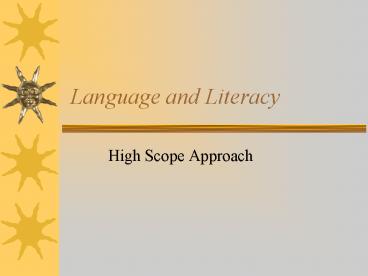Language and Literacy - PowerPoint PPT Presentation
1 / 14
Title: Language and Literacy
1
Language and Literacy
- High Scope Approach
2
Basic Beliefs about Language and Literacy
- Spoken and written language are interconnected.
- Emergence of language is a dynamic process
- The primary function of Language is communication
between people. - Language and literacy develop in young children.
3
Basic Beliefs continued
- Language and literacy develop through
interactions. - Early childhood settings that value language and
literacy and noisy and ACTIVE!
4
Supporting language and literacy (speaking and
listening)
- Talking with others about personally meaningful
experiences. - Describing objects, events, and relations.
- Having fun with languagelistening to stories and
poems, making up stories and rhymes.
5
Supporting language and literacy (reading and
writing)
- Writing in various ways drawing, scribbling,
letter like forms, invented spelling,
conventional spelling. - Reading in various ways reading storybooks,
signs and symbols, ones own writings. - Dictating stories.
6
Suggestions
- Establish a climate in which children are free to
talk. - Sharing control between adults and children
- Focusing on childrens strengths
- Forming authentic relationships with children
- Making a commitment to supporting childrens
play. - Adopting a problem-solving approach to social
conflict.
7
Be available for conversation throughout the day.
- Place yourself at the children's physical level.
- Listen carefully to what children are saying.
- Give children control of conversations.
- Accept childrens hesitations and non verbal
utterances. - Learn and remember each childs particular
interests.
8
Encourage children to talk with one another
throughout the day
- Provide opportunities for cooperative projects
and play. - Support children who wish to play together.
- Refer one childs questions and problems to
another child. - Interpret and deliver messages.
- Explain the context of children's
messages.Acknowledge conflicting viewpoints.
9
Converse with ALL children
- Make time to talk with children.
- Look for comfortable opportunities for dialogue.
- Be aware of your personal preferences.
10
Reading with Children
- As a general rule try to read with small groups
of children rather than the whole group. - Sit on the floor so the children can cluster
around you. - Maintain a balance between new and old favorite
stories. - Reread childrens favorites at their request, or
at your initiative. - Read interactively and with pleasure, pause for
comments and questions.
11
Reading continued
- Make story reading a regular part of your daily
routine, so children can count on it. - Read at other times of the day also.
12
Story telling,
- Pass around a basket of props and have each child
take one and add on to the story. - Rewrite an old favorite story
- Have opportunities and props to retell favorite
stories. - Start a story with the children and let them add
onto it.
13
Writing
- Provide a variety of writing and drawing
materials. - Anticipate various emergent forms of writing.
- Drawing
- Scribbling
- Letter like forms
- Invented spelling
- Conventional spelling
14
Writing
- Encourage children to write in their own way.
- Display and send home samples of writing
- Provide a print rich environment































